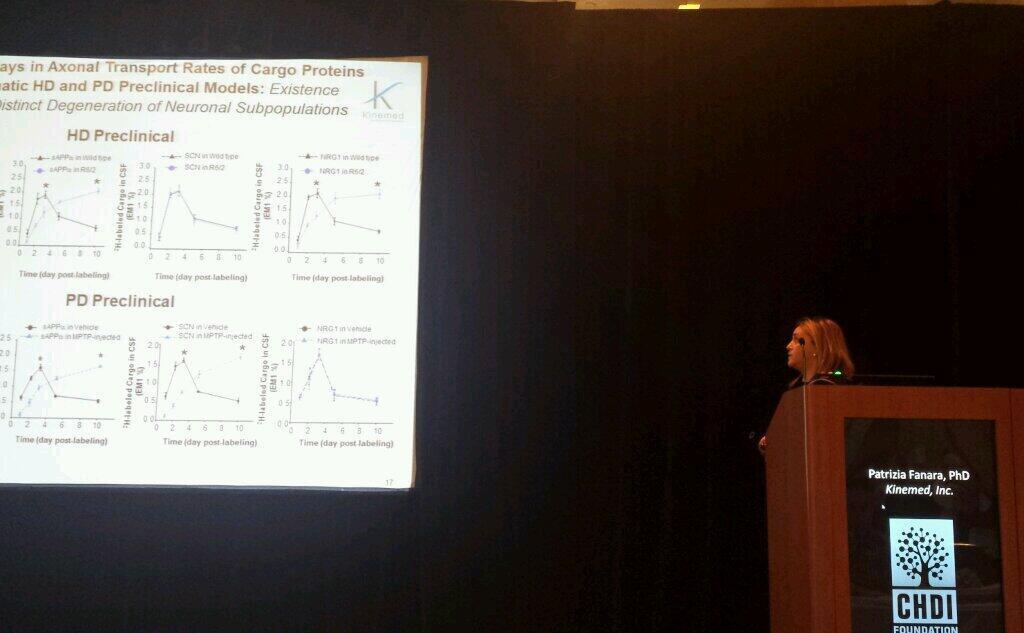Huntington's Disease Therapeutics Conference 2014: day 3
Biomarkers and preparing for trials: the third & final day of the 2014 Huntington's Disease Therapeutics Conference
 By Professor Ed Wild February 28, 2014 Edited by Dr Jeff Carroll
By Professor Ed Wild February 28, 2014 Edited by Dr Jeff Carroll
Our final reports from the Huntington’s disease therapeutics conference in Palm Springs.
Morning session: Biomarkers
09:10 - Good morning from the last day of the HD therapeutics conference in Palm Springs! We start today with “biomarkers”

09:11 - The field of HD has a critical need for read outs from the body that indicate whether HD therapies are working or not
09:12 - Many researchers are trying to find markers of disease progression in HD patients, beyond simply waiting for changes in symptoms
09:14 - Read about HD biomarker development on HDBuzz at: http://en.hdbuzz.net/topic/22
09:16 - Andreas Weiss works on measuring levels of the Huntingtin protein, encoded by the HD gene, in blood and spinal fluid from humans
09:18 - This could be a critical technology to help scientists planning “gene silencing” trials
09:19 - If a drug reduces levels of the huntingtin protein in the brain, how will we know it worked?
09:20 - Not many volunteers for brain tissue donation!
09:25 - Weiss has published work describing technologies to quantify HD protein levels in blood cells
09:26 - These techniques work, but lack the sensitivity required to measure HD protein levels in blood and other fluids
09:28 - New techniques are 1000-fold more sensitive, allowing the detection of a tiny amount of HD protein
09:34 - The technique even works with spinal fluid, which is fairly routine to collect from trial participants
09:36 - This could be a very important tool for future gene silencing trials!
09:40 - The technology works also in blood samples, which might be useful for other types of trials
09:54 - Patrizia Fanara of Kinemed introduces a new technology for measuring the production of new proteins
09:56 - Kinemed’s technique involves ‘heavy water’. Water is H2O, the H being hydrogen. But there’s a heavy form of hydrogen called deuterium
09:57 - When deuterium is used to make water, you get D2O or heavy water. It’s safe and non-toxic and behaves just like water in the body
09:57 - But because it weighs a tiny bit more, machines called mass spectrometers can detect new proteins made from heavy water.
09:58 - Measuring proteins containing deuterium allows us to calculate how much protein was made since the person drank the heavy water
09:59 - More detail of Kinemed’s technologies http://www.kinemed.com/Corporate/Key-Technologies/introduction.aspx
10:01 - Heavy water labelling could enable us to get a readout of how much huntingtin protein the brain is producing each day
10:02 - Measuring the production of new huntingtin would be super-useful in trials of drugs aiming to shut off production of huntingtin.
10:07 - Right now, Kinemed is using its technique to study how huntingtin affects the manufacture and movement of proteins in HD mouse brain
10:23 - Kinemed’s technology has already been tested in Parkinson’s disease patients to look at the production of new proteins in the brain
11:05 - Stephen Morairty, SRI international, uses “EEG” to measure brain activity of HD mice over time
“New techniques are 1000-fold more sensitive, allowing the detection of a tiny amount of HD protein. This could be a very important tool for future gene silencing trials! ”
11:07 - An “EEG” uses electrodes on the surface of the brain to record brain activity, which can also be done in human subjects
11:09 - This is important, because it means that EEG changes observed in HD mice can be quickly examined in human HD subjects
11:11 - Morairty is especially interested in brain changes during sleep, which is disrupted in HD
11:18 - The EEG patterns of HD mice are very different from normal mice, during all phases of the sleep/wake cycle
11:26 - In HD mice, changes in brain activity measured by EEG are observed at very early ages
11:29 - Morairty would next like to see if drugs that help HD symptoms in mice rescue changes in their brain activity patterns
11:42 - Kevin Conley of University of Washington is working on new ways to measure energy production and usage in HD brains
11:46 - Conley uses magnetic resonance scans to examine the chemical composition of body tissues in humans and animals.
11:47 - Conley’s technique is called magnetic resonance spectroscopy (MRS).
12:01 - Conley has found evidence of abnormal metabolism in HD muscle. That makes sense as we know the HD gene affects energy use.
12:04 - Next Conley wants to look in the brains of HD patients.
12:08 - Conley’s scans can detect subtle changes in the balance of energy-related chemicals in cells.
Afternoon session: Clinical Discovery
14:13 - Nellie Georgiou-Karistianis represents the IMAGE-HD study, which overlaps different types of brain scans study changes
14:15 - She’s especially interested in “functional” scans, which investigate patterns of brain activity rather than brain structure
14:17 - Despite early changes in brain structure, HD mutation carriers maintain normal thinking abilities for many years
14:19 - One of the goals of the IMAGE-HD study is to try and understand how people’s brains are compensating for ongoing loss
14:26 - They’re looking for correlations between how brains function and changes in behavior in people who carry the HD mutation
14:31 - Over the course of a few years, IMAGE-HD researchers were able to see progressive changes in how HD mutation carrier brains work
14:56 - Andrea Varrone of Karolinska Institutet has been doing clever brain scans to study a drug target in HD
14:58 - The target is PDE10, which is an enzyme involved in the functioning of synapses (the connections between neurons)
14:58 - Several drugs aimed at altering PDE10 are already being tested by folks like Pfizer and Omeros
14:59 - The hope is that these PDE10 drugs will help with several symptoms of HD. Here’s our article on them http://en.hdbuzz.net/086
15:01 - Studying PDE10 using special brain scans should help us understand the role of PDE10 in HD and could help with PDE10 inhibitor trials

15:05 - Varrone: the scans show reduced PDE10 in the brains of HD patients.
15:11 - That might seem odd, since the drugs aim to reduce PDE10 activity, but the theory is that brain cells with more PDE10 die early
15:12 - That leaves the overall level of PDE10 detected by the scans lower. But inside individual cells, it may still be overactive
16:05 - Alpar Lazar studies sleep changes in people who’ve inherited an HD mutation but don’t yet have symptoms of disease
16:10 - Surprisingly, though we know sleep is critical for humans, it’s not completely clear why we do it
16:11 - Even short term sleep disruption has a major impact on brain biology
16:16 - A number of studies have examined sleep in HD patients, and generally show that their sleep patterns are disrupted
16:18 - Lazar describes the results of a larger study, just completed, to understand sleep disturbances in HD patients
16:25 - In a lab environment, HD mutation carriers seem to go to bed earlier, but wake up later than people without a mutation
16:26 - But these changes were fairly subtle, compared to HD mouse models
16:27 - People with HD mutations also seem to have more fragmented sleep, waking up more often
16:34 - Brain waves of human HD mutation carriers are a bit different than people wihtout a mutation, but not as different as HD model mice
16:39 - Lazar’s group is also studying HD mutation carriers to look for changes in whole body metabolism
16:52 - Tom Warner, UCL, is studying hormonal changes in HD patients
16:56 - He studied volunteers over the course of a day in a hospital to carefully study their metabolism
16:58 - The study was done with about 15 control subjects, 15 people with HD mutations but no disease, and 15 HD patients
17:05 - Levels of melatonin, a hormone that regulates sleep, were notably lower in HD mutation carriers, compared to controls
17:13 - Most things in Warner’s hormone study were completely normal, even in people with overt symptoms of HD
17:38 - The poster prize has been awarded to Vadim Alexandrov who led a study of new automated ways of measuring abnormalities in HD mice
17:42 - And with that, the 2014 Therapeutics Conference is over! After a brief pause to eat and drink, these 300 scientists will now get back to work on HD treatments!
Sunset conclusions
As exciting new therapies approach clinical testing for HD, we will need new technologies to determine whether they work. This is especially important if we want to test new drugs in HD mutation carriers without symptoms of the disease.
Today we heard about new ways of scanning HD mutation carriers brains, and even muscles, resulting in a huge range of new possible outcomes for trials. Hot off the presses data revealed that technical advances have enabled researchers to quantify the HD protein from tiny samples of blood and spinal fluid. This brand-new capability could be incredibly powerful for quickly approaching gene silencing trials.
We’re leaving Palm Springs with the feeling that a lot of hard background work is starting to pay off. We’re looking forward to seeing all these techniques applied to the problem of running better, more decisive, clinical trials for HD!


